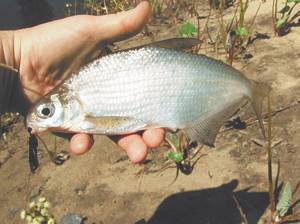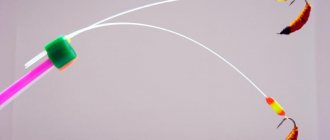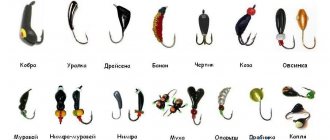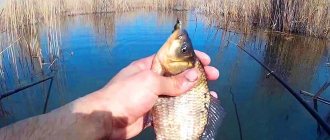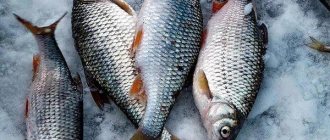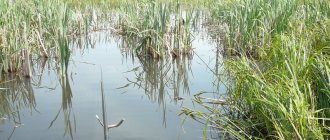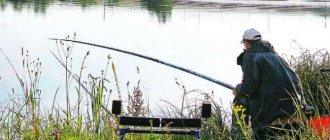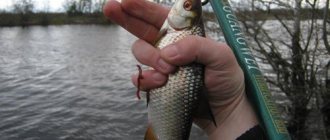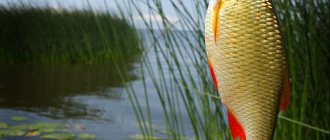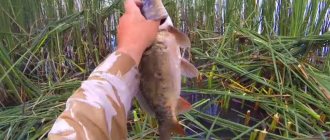Features of the method
To successfully fish with a side nod, you need to find a body of water with a weak current. Of course, it is best if it is a lake. As always, the main recommendation is the active behavior of the fisherman. You need to find a good place where there is a school of carp, crucian carp or other fish. The struggle for existence forces the fish to compete with each other, snatching the bait. If you can get to such a successful catching place, then with good feeding, success is guaranteed. The bites will follow one after another.
Browse products for inventors. Link to the store.
If you are on a stagnant body of water, you can be sure that the fish will not leave the place if it is attracted by the smell and taste of the bait. If the flock moves to another place, try to follow it. To keep the fish in, throw in handfuls of peas, corn and other attractive foods from time to time. This may not always give results, since the fish moves not only at the bottom, it can be in the upper layers. But even in this case, she will be attracted by the sight of food descending on one.
How to fish with a side nod
It all depends on the choice of equipment, and, in fact, on the place where you fish. Any body of water where the water is standing or the current is very weak is suitable. You will have to constantly move, because the goal is to search for active schools of fish. There is always competition for food within the flock. Therefore, if you find a fish, it will bite until they notice something wrong and decide that they need to change their location. We don't stop there. The fish must be found again. Sometimes bait works. But if it quickly falls to the bottom, it will be of no use. And there is no point in tying yourself to this place. The school of fish will still go to another place.
Think about where you will fish from. Ideal options are dams, piers, and walkways. You can put your waders on something warm and go fishing in early spring. The entire area along the coast is our target area. This is where fish most often end up after the ice melts. It’s easiest to fish this way in windy weather. Then you can get closer to potential prey much easier. Practice has shown that blind equipment causes a lot of inconvenience. Especially if you need to lose the line while fishing. If the fish does not get tired, then it is quite possible that the line will break and the fish will go to depth. You always need the opportunity to drop the line.
Read! Where to catch live bait in the fall
What to consider when fishing with a side nod
Which weather is better: calm or windy? In strong winds, fishing becomes almost impossible - the load on the rod will become unbearable. If there is a light wind on the reservoir, then this is a sign of likely successful fishing. Thanks to the weak wind, the water is evenly mixed, which has a good effect on bites. In addition, it is necessary to take into account that the fish are easily noticed by a person with a fishing rod on the shore and can be very careful if they notice you. If you are fishing by wading, you should enter the water very carefully and slowly so as not to stir up turbidity.
Tackle
When fishing with a side nod, 2 options for rigging a fishing rod are usually used. 1. Running – includes a fishing rod equipped with rings and fishing line. The latter is wound onto a reel. Nod, he has wire rings on him. 2. Blind – shaped like a fly rod, with a foam reel on it.
DIY electronics in a Chinese store.
DIY side nod
Many people ask the question - how to make a nod with your own hands? Some people simply lack ideas, or some simple technical points seem incomprehensible. But it's not all that complicated. The material for the nod is inexpensive. Any springy one will do. But the easiest way is to take a regular plastic clamp. There are a dime a dozen of them around and they don’t cost anything. And depending on the length and thickness, we can make a nod with the desired level of sensitivity. Next we need copper wire. On average - from 0.5 to 1 mm2. It is required to make the middle ring and tulip. Now we tape the ring to the smooth side of the clamp with electrical tape. The nod will be springy. If you want more strength, take superglue. It definitely won't get any worse. Heat shrinking won't hurt either.
Read! Pike fishing in April
Then we make a corner from 1 mm2 copper wire and attach it to the tip of the rod. We attach the smaller side of the corner to the clamp. We do this exactly the same as with rings. You can decorate everything with colored electrical tape, heat shrink, and even nail polish. It is recommended to make a flag out of colored electrical tape and place it on the tip of the nod. This way you won’t lose sight of it while you’re fishing in the reeds. We take a fishing rod up to five meters long. It requires fasteners for the coil and ring. We attach the nod with electrical tape.
A rod that is used for side cast fishing
The rod is a budget Flagman. Although what is shown in the video has already been discontinued. The rod rode like a fly rod, but the master put rings on it.
Weight without rings 465 g. The manufacturer did not indicate the test in the description. The rod was initially positioned to fight large fish. It’s a little heavy, but it copes well with carp in a power fight.
The rod is quite powerful. At 7 kg the nod has not yet come across, but she will pull it. At least when you hold a large carp, there is no feeling that it is about to burst. The nod is an ordinary one, bought at a fishing store. True, there was a problem related to the fact that the heat shrink that fixes it to the spring was weakened, and it often flew off when playing, but this problem has already been solved.
Fishing with a side nod is shown in the first and second videos.
Side nod is an excellent solution for snags
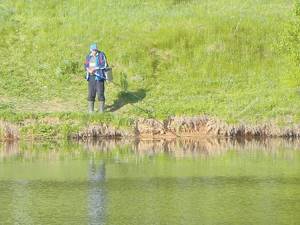
The side nod has recently become quite popular among active fishing enthusiasts.
This fishing is not designed for lazy fishermen.
Being a popular fishing activity, it is in many ways similar to spinning predator hunting.
The same wanderings along the shores overgrown with wild roses, when you have to simultaneously brush off mosquitoes and unhook the fishing line from the bushes, make test casts to the most seemingly attractive and mysterious places where the fish should definitely be standing.
But the fish does not know about this, and often in such beautiful places, in the opinion of the fisherman, there is not a bite.
And so you have to walk further along the shore, looking for your treasured window among the grass, snags and other “saplings”.
For some, this is spring fishing, for others, there is nothing better than fishing on a side nod on a summer morning among dense thickets of golden egg capsules. But let’s focus on spring fishing, since it’s still spring.
Often the most catchy places on a spring river are thickets of dry grass, sedge, old reeds and willow bushes standing in the water. Rivers sometimes take a long time to reach their banks.
How can one determine that there are fish in such “strong” places? And it’s very simple: probably more than one fisherman, wandering in the “swamps” through melt water among coastal small forests, scared away large fish that were literally under his feet, and then quickly went into the bushes, raising a wave.
Since the water in spring can be cold, like in winter, the fish simply come out to bask in shallow waters warmed by the sun. Here, in the old sedge and dry reeds, there are a lot of different small living creatures in the form of larvae, worms and beetles. And among the flooded bushes there are already enough insects that have fallen into the water. The bushes are also good shelters, with warmer water than in the river flow.
Read the material “Spring in Special Places”
But the trouble is that you can’t catch fish here with a float rod, bottom and feeder, even if it splashes in front of your eyes at a distance of 6-8 meters. It seems that she is aware of the complete weakness of a fisherman with a simple fishing rod, and will poison the soul even more, diving, splashing and almost snorting in the coastal bushes, mocking the klutz fisherman...
And only fishing with a side nod can bring prey, luring the crafty fish out of the bushes and grass with a jig. And here there is no need for bait, which is already enough in the thickets.
While your fellow fishermen are mixing bait on the shore, looking for the far and near edges with a marker weight, and unwinding the feeders, you can already catch a couple of good fish, for example, bream, ide, sorghum or chub. This large fish often stands in thickets at a depth of no more than half a meter.
You just need to very quietly approach the fishing spot and just as quietly throw the jig with bloodworms, dung worms or maggots into the gaps between the bushes or reeds.
If the fish stands in this place, then the bite often follows right there. If there is no bite, then you should lift the jig from the bottom and make several oscillating movements with the bait, tapping it on the bottom.
After catching fish, you can safely move to another place. Only after some time can you return to your previous catchable place, which will be occupied by the newly arrived ide or bream.
This is a minus of fishing in shallow water in small nooks among the grass, where several fish are cramped at once. But the plus, as already mentioned, is the active sport fishing on the banks of a beautiful river, where spring birds click, whistle and trill to everyone’s attention.
|
| Photo: Alexander Tokarev. |
The side nod can be spring or silicone, which is used for catching pike perch with a spoon or jig with a sprat. All you need is an attachment for moving the side nod to the side, which makes the bite more noticeable. After all, the nod is located at the tip of the rod, the length of which is often 7-8 meters. Flat lavsan nods are also used, but they are difficult to see at a long distance.
Read the material “Gun owners may be required to wear identification marks”
The main requirement for a fishing rod is lightness. Carbon-fiber rods are the lightest, but they are also the most fragile, which makes it necessary to protect them from any blows, even weak ones. Composite and fiberglass rods are strong and simple, like the “brute force”, but much heavier. It will be difficult to keep them suspended for a long time, but... tolerable.
The jig can be of any shape and weight, but a miniature tackle with a thin fishing line, 0.12 mm in diameter, and a small tungsten jig, dark for a bright day and silver for a gray, foggy morning, works better.
Unexpected success was once brought to me by a mothless goat, which in winter was good at catching a wide variety of fish from the ice. Here, in open water, in the grass, a large roach attacked it, but only with the addition of a bloodworm head. Then other fish took this jig, but still in the same way, with the addition of a bloodworm or a worm.
Apparently, as a baitless jig, this jig does not work at shallow depths, but it attracts fish, especially if there is something edible on the hook.
The fishing tactic is that the bait with bait is lowered vertically on a fishing line from the tip of the rod, like in a hole in winter. Usually small gaps and windows are chosen among grass and bushes.
The jig either lies motionless on the bottom, or makes smooth movements near the bottom, touching it and raising the mud. It should be taken into account that the fishing line for such fishing is always shorter than the rod, and after hooking it is necessary to release the fishing line from the reel so that its length is equal to the length of the rod, that is, sufficient for landing fish on a “dead” rig.
Read the material “Fleece clothing is a reliable choice.”
You can use a rod with guides and a spinning reel, but you will have to make a side nod so that it can freely pass the line.
From somewhere, huge crucian carp suddenly came to our city river. More than once I have caught similar strong crucian carp from a motor boat along with bream and ide on the swift Volga stream.
And at the mouth of the Bolshaya Kokshaga, at the confluence with the Volga, there are many of these silvery beauties. Now they have partially become sedentary in our waters, living in oxbow lakes and bays, and some of them rise from below to our places every spring. And during this move along the Malaya and Bolshaya Kokshaga, spring crucian fishing begins.
This is a fishing holiday, when every now and then you come across fish weighing up to a kilogram, and half a kilogram is common. But the banks of the river within the city at this time are densely packed with fishermen so that sometimes there is nowhere to stand. But this kind of fishing is not for me, even if the fish are large.
This morning Pashka and I are trying to find a place on the shore that is at least somewhat free for fishing. But all the places had probably been occupied since the night before.
I remember that downstream there is a large pool, where not everyone can reach through potholes and lowlands, still filled with melt water, even though spring is already in full swing. We wander there, crossing streams and flooded lowlands in waders.
But fishermen also sat on the banks of the pool. Only the willow bushes standing in the water were free. Who will go there with a fishing rod?
Read the material “Journey along the river bed”
Stopping at the bushes, I suddenly saw how our steps stirred the water near the nearby taliks, and something splashed under the branches with young foliage. And only the big breaker remained on the calm water, swirling around the edges like funnels.
It also splashed at the neighboring bush. There was clearly some kind of large fish that had entered from the current into the solid willow forest. - Saw? - I push my friend. “So he’s not blind,” he fusses, grabbing the fishing rods.
I had a fishing rod with a side nod. I already found myself in a similar situation in the spring and built some gear. Pashka tried to fish with a float, but immediately caught a branch with his hook and broke the fishing line.
And I aimed at the gap between the bushes, which shone like a window among the thick branches, six or seven meters from the shore. Going quietly into the water, as far as the raised “swamps” allowed, I lowered a small jig with a small and nimble dung worm into the gap.
Here is the bottom... It’s no more than a meter away. Small, but there are fish here. This can be seen even from the bushes, which are noticeably shaking and clearly not from the current, which simply was not there.
He slightly raised the jig and immediately the nod sharply bent downwards, and a shock was noticeably transmitted through his hand. Bite!..
A stubborn fish came briskly on the line, glistening in the shallow water. This is a crucian carp, and not a small one. Soon he splashed around in the fish tank.
Read the material “Lessons in reelless fishing on a summer cottage lake”
They didn’t take crucian carp often, but when changing places, one or two crucian carp always grabbed the jig. Pashka, unable to bear it, built something similar to my gear, but the role of the side nod was performed by the flexible tip of the rod, which also coped with this role.
And my friend began to catch medium and large crucian carp from time to time. The morning was a success...
Alexander Tokarev July 30, 2021 at 11:04 am
Fishing place, bait and bait
You need to start fishing with a side nod by determining the location. You need to feed point by point, literally 100 grams of peas per point. The fisherman himself usually feeds 5-10 points. After 40-60 minutes, you can come up and check if the school of fish has arrived. No need. 1-2 handfuls of bait per point is enough.
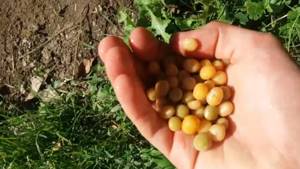
Every pea has a sprout. At this point we pierce the pea right through and let the sting come out several times. We return it a little so that the sting hides. It can easily come out of the peas when hooked.
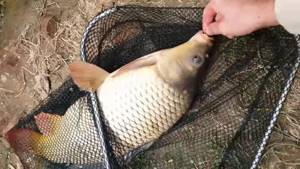
Channel “Nazar Avramenko”. Fishing with peas.
Notes
One of the comments. Alexander Bataev: I fish exactly the same way, only with corn. For some reason I have significantly fewer bites for peas. Apparently our fish prefers corn. Tica Premiera fishing rod is 5 meters, but I want to find an option for 7 meters. I haven’t seen Flagman for sale here.
I first glue the place where the nod is attached to the spring with super glue, and then, until the glue is completely dry, I crimp it with heat shrink. The metal nod made from a clock spring holds the wind very well; it is assembled using the same principle through a spring, but I use it very rarely. Of the customizable nods, I bought myself a few Whisker pieces, but haven’t tested them yet. They look very well made. Those with different weights are of the spring type, but have inertia and therefore sensitivity may suffer. In a word, I need to check, but the season is already over and now I’ll wait for next year.
Watch catching crucian carp with a side nod video for free
Catching Crucian carp with a side nod (Crucian carp video) - Clip
Catching crucian carp with a side nod. On a fishing rod with a summer nod.
catching crucian carp on a fishing rod with a side nod
Fishing, catching crucian carp in the spring on a side nod with a jig in the reeds
Catching crucian carp in the spring with a side nod from the shore. Useful tips
Fishing with a side nod. In early spring
Side nod fishing for crucian carp and spruce
Video from Vova “Mandrika”: Catching crucian carp with a side nod
Catching large crucian carp on a fishing rod with a side nod on a wild river
I caught it with a summer fishing rod with a side nod and a float rod. shooting from two cameras. Fishing with a float
Fishing for crucian carp, autumn side nod, qualifying trophy***My fishing report
Successful fishing for crucian carp in the reeds with a rod with a side nod
My summer fishing rod with a Side Nod. Fishing. Fishing. Underwater photography. Bites. Homemade products
Super carp fishing with a rod with a side nod from the shore
Homemade side nod
Catching carp in snags with a rod with a side nod. Useful tips
Catching carp with a summer jig, with a fishing rod with a side nod.
Spring fishing for side nod, goby and crucian carp. Lake "Sramnoye" Beloozersky village.
Fishing with a side nod
.ne, YouTube Fishing for crucian carp with a side nod
Catching carp on peas with a side nod from a boat in snags
How to make a fishing rod with a side nod for a summer jig
Catching wild carp - carp in summer using a side nod***carp fishing
Roach on the side nod (Opening of the summer season 2016)
Fishing for carp: In a strong snag on a side nod.
Spring fishing for crucian carp on the river with a fishing rod with a side nod (03/16/2015)
Summer jigs for side nod fishing
Fishing for carp with a fishing rod with a side nod from the shore. Useful tips
Catching wild carp (carp) on the river with a fishing rod with a side nod
SUMMER SIDE NOD - MANUFACTURING, DEVELOPMENT. FISHING ON THE SIDE NOD
Side nod for catching crucian carp
My summer fishing rod with a Side Nod. Fishing. Fishing. Underwater photography. Bites.
A catchy fishing rod with a nod for catching large carp and crucian carp in the reeds
FISHING with a SIDE NOD
SIDE NOD FOR CRUCCIAN
FISHING on a SIDE NOD with a SUMMER JIT on SMALL RIVERS
Catching huge carp with a fishing rod in snags on the Ros River / Catching huge carp
Catching carp with a summer jig. Fishing report(06/08/2015)
Catching crucian carp with a nod (May 3, 2016)
Synchronized shooting under and above water of bites on a fishing rod with a side nod and a float rod. Fishing
Side nod to crucian carp (unsuccessful fishing, almost no bite)
Side nod. Crucian carp on the ponds.
SIDE NOD for SUMMER FISHING WITH YOUR HANDS
BITES on a fishing rod with a side nod and a float rod. Synchronized shooting above and under water. Fishing
Fishing for large crucian carp that breaks fishing rods
In May with a side nod. Part II. Fishing for crucian carp in ponds
Catching Perch and Fishing with a Side Nod (Perch Video) - Clip
BITES on a fishing rod with a side nod and a float rod. Synchronous shooting under and above water. Fishing
Fishing with a jig (side nod). Blind equipment. Without nozzle.
Source: https://nature-photography.com/video/4043-lovlya-karasya-na-bokovoy-kivok-video/
